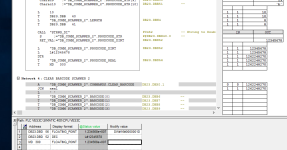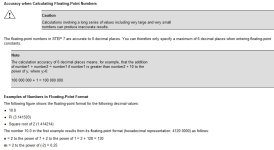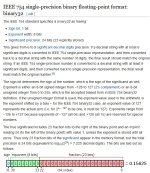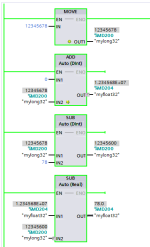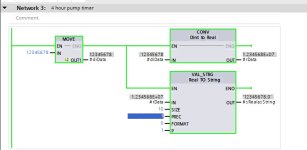You are using an out of date browser. It may not display this or other websites correctly.
You should upgrade or use an alternative browser.
You should upgrade or use an alternative browser.
Simple conversion from DINT to REAL fail
- Thread starter userxyz
- Start date
L D[AR2P#0.0]
Lifetime Supporting Member
Hi
Hi,
Thanks for your reply.
But on Wonderware I also have 12345680,0
So the 7 is gone...
It also shows wrong...
Hi,
Thanks for your reply.
But on Wonderware I also have 12345680,0
So the 7 is gone...
It also shows wrong...
e.g.
L D[AR2P#0.0]
Lifetime Supporting Member
Deleted my misleading post. Floating point mantissa is 23 bits so 12345678 will not fit hence loss of precision.
Steve Bailey
Lifetime Supporting Member + Moderator
32-bit floating point numbers give you seven significant digits. This is the case for all devices, not just the PLC. So a DINT 12345678 will be rendered as 1.234568 x 10^7 in 32-bit REAL. Note that the 8-digit 1.2345678 rounds to 1.234568.
The highest integer that can be represented exactly by an IEEE 754 float is 16,777,216.
[edit] so, your integer of 12,345,678 should fit. Unless Siemens floating point numbers use a different structure to IEEE 754?
[edit edit] which is exactly what L D[AR2,P#0.0] posted in his first reply. Siemens floating point for some reason appears to have 6 significant figures. I should read more carefully.
[edit] so, your integer of 12,345,678 should fit. Unless Siemens floating point numbers use a different structure to IEEE 754?
[edit edit] which is exactly what L D[AR2,P#0.0] posted in his first reply. Siemens floating point for some reason appears to have 6 significant figures. I should read more carefully.
Last edited:
drbitboy
Lifetime Supporting Member
Deleted my misleading post. Floating point mantissa is 23 bits so 12345678 will not fit hence loss of precision.
It's actually 24 bits of total* mantissa cf. here - don't forget the "invisible" MSbit that is a 1: 24 bits of mantissa; 8 bits of exponent (excess 127); 1 bit of sign; talk about 33 punds of baloney in a 32-pound bag!
* not stored
So a 32-bit float should not lose precision until it goes above 2**24 = 16,777,216, and 12,345,678 is less than that.
The problem is not in the bits representing the number.
In the OP example, 12345678 is still in the float, and that can be verified by copying it back to another DINT (is anyone interested in a wager?
Last edited:
drbitboy
Lifetime Supporting Member
The highest integer that can be represented exactly by an IEEE 754 float is 16,777,216.
Your integer of 12,345,678 is simply too large to be exactly represented by a floating point data type, and will be effectively represented as 1.234568x10^7
Umm since when is
12,345,678 greater than
16,777,216
?16,777,216
Glitch in the matrix. Have edited my post (twice, in factUmm since when is12,345,678 greater than?
16,777,216
drbitboy
Lifetime Supporting Member
Hi,
Anyone who understands this issue...
I try to convert 12345678 DINT to REAL
And I get
12345680,0 in REAL ????
Well, actually it looks to me like you got 1.234568E+007, which is not identical to 12345680,0.
OT: do we call that thing between the zeros a "decimal comma?"
L D[AR2P#0.0]
Lifetime Supporting Member
Commas as decimal places are quite common in Europe. Or more to the point (excuse the pun), the "," symbol is the decimal separator, and in some cases, the "." symbol is used to separate the thousands in a long number, the way the USA does with the "," symbol.OT: do we call that thing between the zeros a "decimal comma?"
e.g. in some locales:
1,234 = a number slightly larger than 1
1.234 = one thousand, two hundred and thirty four
Whereas in the US, it would be the other way around.
This is one of many reasons managing different languages and system locales is a challenge for SCADA software (and computing in general)
drbitboy
Lifetime Supporting Member
L D[AR2P#0.0]
Lifetime Supporting Member
drbitboy
Lifetime Supporting Member
Interestingly, their very own conversion block gets it right:
Noice.
These last two posts, especially L\ D's, put the nail in the coffin for this thread: the software (TIA Portal?) chooses to display at most 1+6 significant digits when it switches to exponent format. That's neither here nor there, but in the bits behind the display everything operates as it should.
Similar Topics
this will be a simple answer for someone who is used to allen bradley
im using a Micro830 with a 2711-T6T panelview, and programming with CCW in...
- Replies
- 0
- Views
- 2,813
Hello again..trying something on an existing poorly written program and just wanted to double check something
system is an A-B MicroLogix 1200
In...
- Replies
- 5
- Views
- 159
Hi all,
Writng a FB in ST on Beckhoff TC for a pulser which turns on and off on a cycle, is paused by turning bControlInput to FALSE, but resumes...
- Replies
- 6
- Views
- 247
I'm trying to build my Classic Step 7 programming skills this weekend. I get stuck on little things that are not covered in YouTube tutorials. I'm...
- Replies
- 7
- Views
- 316
I have a program that does a 7 second "scan" sensor calibration routine whenever a setting (setting is called assistance level or "AL" and ranges...
- Replies
- 3
- Views
- 212



